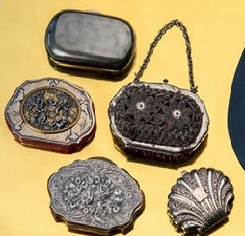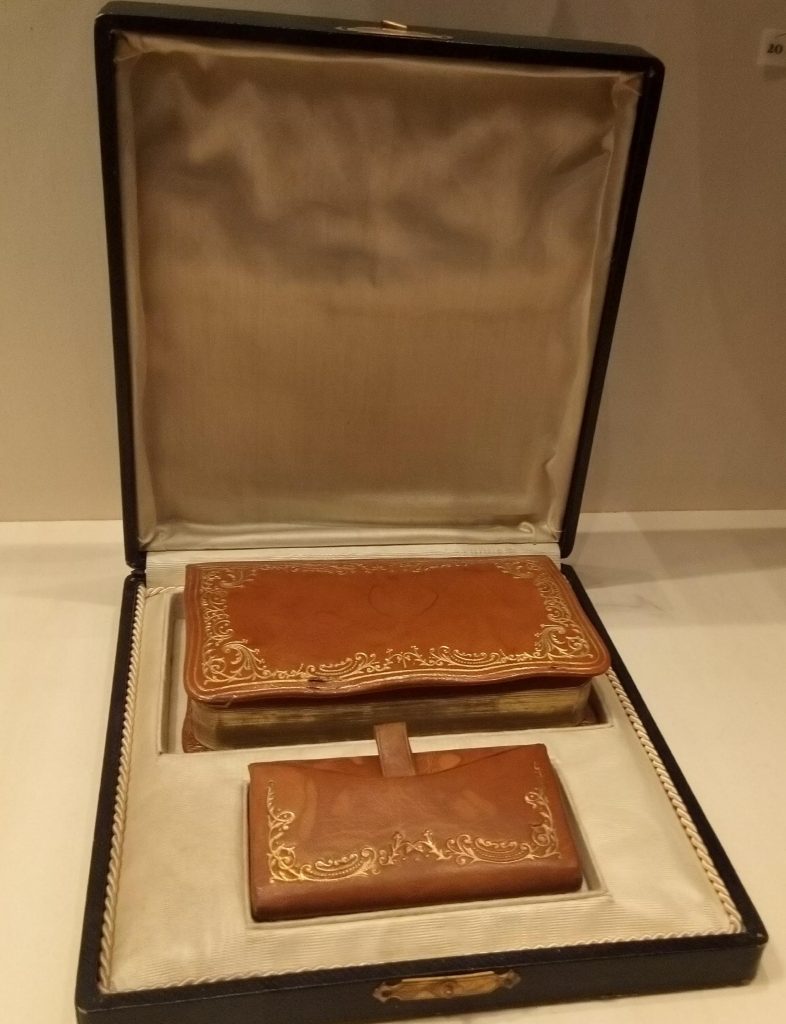
An exhibition of purses and wallets at the Musée de la Monnaie, Paris provides a detailed look at some unusual objects and techniques but leaves some wider questions unanswered. Based on a private collection, the emphasis is on pieces of technical or aesthetic interest. From this perspective the exhibition does not disappoint – there are purses in the form of tiny knitted gloves with clasps in the shape of knitting needles; purses made from mussel shells; purses imitating enamelled watches; and purses made from chased and engraved metal. Most of these are small enough to fit in the palm of the hand and some even smaller, miniature wallets made for fashion dolls.
The small scale of the selected pieces – while understandable in terms of collecting and exhibiting policy – also raised some issues. Cases smaller than a modern credit card would be limited in the number of coins they could contain. They might be interpreted as holding just enough for tips or transport on a day out – except that many were fitted out as ‘porte-louis’ with clips to hold gold coins and no room for lower denominations. Thus they functioned as high-value containers for even higher-value contents. Purses so small would normally be carried in a pocket and brought out with a flourish. Other examples in the exhibition were made with finger rings or wrist loops to be carried openly as a display of both financial and aesthetic capital. The most interesting section of the exhibition touches on this topic, and on the ways in which purses encoded social hierarchies and gender roles.

This was strikingly evident in the ‘ecrins de mariage’, gift boxes presented by the upper-class bridegroom to his bride as part of the ‘corbeille de mariage’. On display to family members and friends, and even to the wider public through reports in women’s magazines, the ‘corbeille’ included items restricted to married women’s use, such as diamond jewellery, handmade lace, and furs or shawls. To contemporaries, it was a concrete demonstration of the regard in which the groom held his bride, and of his intention to provide everything suited to her new status. But from our viewpoint, the ‘corbeille’, and especially the ‘ecrin’, can be seen as metaphors for the bride herself. The tastefully decorated ‘ecrin’ had no function but to contain the gifts inside. These typically included a matching prayer book and wallet to assure the recipient’s spiritual and temporal welfare. In turn the wallet gained value from the coins it contained, just as the body of the bride, under all her lavish finery, was valued as the carrier of future heirs.
The social hierarchies encoded in the carrying of money – and especially in gifts of money – are left vague in the exhibition. There are several examples of purses commemorating the recipient’s first Holy Communion, but these are not linked to the practices of alms giving that often formed part of the ceremony. Instead, cross-class relations are displaced into the animal kingdom with purses that depict an encounter between an aristocratic hunting dog and a peasant sheepdog. The need for purses to securely hold working people’s scarce cash is implied in a section on late-nineteenth century innovations that included a seamless leather purse, advertised with posters of a lion tamer. If, as the exhibition catalogue states, there were nearly 600 patents for improvements to wallet clasps between 1850 and 1900, there was clearly an increasing need for purses and by implication an increasing monetarisation of French society. In a museum dedicated to the history of money, it would have been good to have more on this social framework, or on the social capital implied by the possession of even a single gold coin, let alone a purse designed to hold it.

The exhibition, ‘Chic et utile, l’art du porte-monnaie’ is at the Musée de La Monnaie until November 3 2019 https://www.monnaiedeparis.fr/en/temporary-exhibitions/chic-and-practical-the-art-of-the-purse
